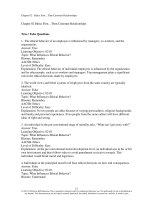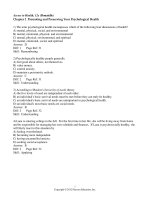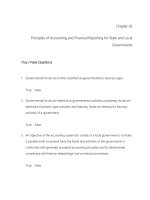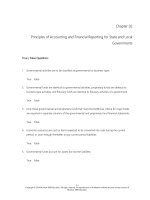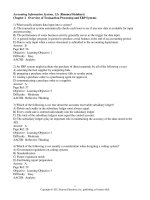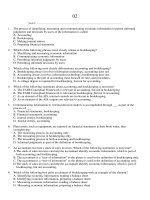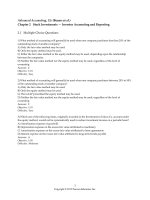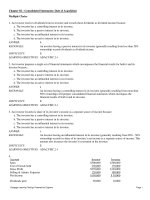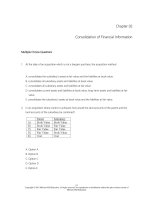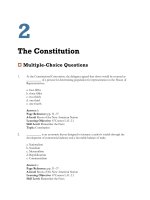American government roots and reform 2012 12th edition OConno test bank
Bạn đang xem bản rút gọn của tài liệu. Xem và tải ngay bản đầy đủ của tài liệu tại đây (211.46 KB, 33 trang )
2
The Constitution
Multiple-Choice Questions
1.
At the Constitutional Convention, the delegates agreed that slaves would be counted as
__________ of a person for determining population for representation in the House of
Representatives.
a. four-fifths
b. three-fifths
c. two-thirds
d. one-third
e. one-fourth
Answer: b
Page Reference: pp. 31–37
A-head: Roots of the New American Nation
Learning Objective: O’Connor L.O. 2.1
Skill Level: Remember the Facts
Topic: Constitution
2.
__________ is an economic theory designed to increase a nation’s wealth through the
development of commercial industry and a favorable balance of trade.
a. Nationalism
b. Socialism
c. Mercantilism
d. Republicanism
e. Commercialism
Answer: c
Page Reference: pp. 31–37
A-head: Roots of the New American Nation
Learning Objective: O’Connor L.O. 2.1
Skill Level: Remember the Facts
Topic: Constitution
3.
In what year was the Declaration of Independence signed?
a. 1776
b. 1801
c. 1797
d. 1789
e. 1805
Answer: a
Page Reference: pp. 31–37
A-head: Roots of the New American Nation
Learning Objective: O’Connor L.O. 2.1
Skill Level: Remember the Facts
Topic: Constitution
4.
How many constitutions has the United States had in its history?
a. three
b. five
c. one
d. two
e. four
Answer: d
Page Reference: pp. 31–37
A-head: Roots of the New American Nation
Learning Objective: O’Connor L.O. 2.1
Skill Level: Remember the Facts
Topic: Constitution
5.
The U.S. Constitution was adopted in response to the weaknesses of the Articles of
__________.
a. Unity
b. Revolution
c. America
d. Democracy
e. Confederation
Answer: e
Page Reference: pp. 37–39
A-head: The First Attempt at Government: The Articles of Confederation
Learning Objective: O’Connor L.O. 2.2
Skill Level: Remember the Facts
Topic: Constitution
6.
The colonists rebelled against the unilateral imposition by the British government of which
of the following?
a. taxes
b. a military draft
c. curfews
d. religious laws
e. health care
Answer: a
Page Reference: pp. 51–55
A-head: The Drive for Ratification of the U.S. Constitution
Learning Objective: O’Connor L.O. 2.5
Skill Level: Remember the Facts
Topic: Constitution
7.
Who was the author of the Declaration of Independence?
a. James Madison
b. Benjamin Franklin
c. Thomas Jefferson
d. Paul Revere
e. John Adams
Answer: c
Page Reference: pp. 31–37
A-head: Roots of the New American Nation
Learning Objective: O’Connor L.O. 2.1
Skill Level: Remember the Facts
Topic: Constitution
8.
Which of the following debated and drafted the Declaration of Independence?
a. Constitutional Congress
b. Continental Congress
c. Revolutionary Congress
d. American Congress
e. Liberty Congress
Answer: b
Page Reference: pp. 31–37
A-head: Roots of the New American Nation
Learning Objective: O’Connor L.O. 2.1
Skill Level: Remember the Facts
Topic: Constitution
9.
Which clause provides that the Constitution shall be the supreme law of the land?
a. full faith and credit
b. legal
c. primacy
d. due process
e. supremacy
Answer: e
Page Reference: pp. 44–51
A-head: The U.S. Constitution
Learning Objective: O’Connor L.O. 2.4
Skill Level: Remember the Facts
Topic: Constitution
10.
Which of the following generally favored a strong national government and supported the
proposed U.S. Constitution?
a. Tories
b. Whigs
c. Federalists
d. Anti-Federalists
e. Constitutionalists
Answer: c
Page Reference: pp. 44–51
A-head: The U.S. Constitution
Learning Objective: O’Connor L.O. 2.4
Skill Level: Remember the Facts
Topic: Constitution
11.
The __________ proposed proportional representation in both the House of
Representatives and the Senate.
a. Ohio Plan
b. Virginia Plan
c. New Jersey Plan
d. Massachusetts Plan
e. Pennsylvania Plan
Answer: b
Page Reference: pp. 40–44
A-head: The Miracle at Philadelphia: Writing the U.S. Constitution
Learning Objective: O’Connor L.O. 2.3
Skill Level: Remember the Facts
Topic: Constitution
12.
How many amendments have been made to the Constitution since its ratification?
a. twenty-seven
b. ten
c. thirty-six
d. twelve
e. fifteen
Answer: a
Page Reference: pp. 28–31
A-head: Chapter 2 Introduction
Learning Objective: Chapter 2 Introduction
Skill Level: Remember the Facts
Topic: Constitution
13.
In what year was the U.S. Constitution ratified?
a. 1776
b. 1797
c. 1791
d. 1788
e. 1777
Answer: d
Page Reference: pp. 51–55
A-head: The Drive for Ratification of the U.S. Constitution
Learning Objective: O’Connor L.O. 2.5
Skill Level: Remember the Facts
Topic: Constitution
14.
Of the fifty-five delegates who attended some portion of the Constitutional Convention,
how many ultimately signed it?
a. thirty-nine
b. twenty-nine
c. fifty-four
d. forty-eight
e. forty-five
Answer: a
Page Reference: pp. 44–51
A-head: The U.S. Constitution
Learning Objective: O’Connor L.O. 2.4
Skill Level: Remember the Facts
Topic: Constitution
15.
Which of the following is a branch of the U.S. government?
a. Congress
b. Supreme Court
c. presidency
d. legislative
e. Senate
Answer: d
Page Reference: pp. 37–39
A-head: The First Attempt at Government: The Articles of Confederation
Learning Objective: O’Connor L.O. 2.2
Skill Level: Remember the Facts
Topic: Constitution
16.
The Constitution specifically provides for both the election and the removal of which of the
following?
a. secretary of defense
b. president
c. secretary of state
d. chief justice
e. Speaker of the House
Answer: b
Page Reference: pp. 40–44
A-head: The Miracle at Philadelphia: Writing the U.S. Constitution
Learning Objective: O’Connor L.O. 2.3
Skill Level: Remember the Facts
Topic: Constitution
17.
Which constitutional amendment allowed voting for citizens who were eighteen or older?
a. Twenty-Sixth
b. Fifteenth
c. Twentieth
d. Twenty-Seventh
e. Nineteenth
Answer: a
Page Reference: pp. 28–31
A-head: Chapter 2 Introduction
Learning Objective: Chapter 2 Introduction
Skill Level: Remember the Facts
Topic: Constitution
18.
Which of the following philosophers greatly influenced the colonists’ views on the role of
government?
a. John Dewey
b. John Locke
c. Martin Heidegger
d. Michael Foucalt
e. George Berkley
Answer: b
Page Reference: pp. 31–37
A-head: Roots of the New American Nation
Learning Objective: O’Connor L.O. 2.1
Skill Level: Understand the Concepts
Topic: Constitution
19.
During the colonial era, the colonists retained the right to do which of the following?
a. wage war
b. regulate trade
c. negotiate treaties
d. levy taxes
e. require compulsory tithing
Answer: d
Page Reference: pp. 31–37
A-head: Roots of the New American Nation
Learning Objective: O’Connor L.O. 2.1
Skill Level: Understand the Concepts
Topic: Constitution
20.
Which of the following required all paper items in the colonies to carry a stamp of the
Crown?
a. Crown Act
b. Paper Act
c. Stamp Act
d. Tax Act
e. Royal Act
Answer: c
Page Reference: pp. 31–37
A-head: Roots of the New American Nation
Learning Objective: O’Connor L.O. 2.1
Skill Level: Understand the Concepts
Topic: Constitution
21.
Which Continental Congress approved the Declaration of Independence?
a. Second
b. Third
c. Fourth
d. Fifth
e. Tenth
Answer: a
Page Reference: pp. 31–37
A-head: Roots of the New American Nation
Learning Objective: O’Connor L.O. 2.1
Skill Level: Understand the Concepts
Topic: Constitution
22.
How many of the thirteen colonies voted for independence?
a. thirteen
b. ten
c. eight
d. twelve
e. nine
Answer: d
Page Reference: pp. 31–37
A-head: Roots of the New American Nation
Learning Objective: O’Connor L.O. 2.1
Skill Level: Understand the Concepts
Topic: Constitution
23.
In what year was the Bill of Rights added to the Constitution?
a. 1776
b. 1788
c. 1789
d. 1798
e. 1791
Answer: e
Page Reference: pp. 44–51
A-head: The U.S. Constitution
Learning Objective: O’Connor L.O. 2.4
Skill Level: Understand the Concepts
Topic: Constitution
24.
Article I, Section 8 of the Constitution contains which powers of Congress?
a. enumerated
b. restrictive
c. military
d. implied
e. executive
Answer: a
Page Reference: pp. 44–51
A-head: The U.S. Constitution
Learning Objective: O’Connor L.O. 2.4
Skill Level: Understand the Concepts
Topic: Constitution
25.
During the Constitutional Convention, which states generally opposed an unelected federal
judiciary?
a. large
b. northern
c. small
d. southern
e. border
Answer: a
Page Reference: pp. 40–44
A-head: The Miracle at Philadelphia: Writing the U.S. Constitution
Learning Objective: O’Connor L.O. 2.3
Skill Level: Understand the Concepts
Topic: Constitution
26.
__________ Rebellion was a protest by Massachusetts farmers to stop foreclosures by state
courts.
a. Brown’s
b. Smith’s
c. Miller’s
d. Shay’s
e. James’s
Answer: d
Page Reference: pp. 37–39
A-head: The First Attempt at Government: The Articles of Confederation
Learning Objective: O’Connor L.O. 2.2
Skill Level: Understand the Concepts
Topic: Constitution
27.
The Articles of Confederation required __________ consent from the states for ratification.
a. three-fifths
b. unanimous
c. two-thirds
d. majority
e. three-fourths
Answer: b
Page Reference: pp. 37–39
A-head: The First Attempt at Government: The Articles of Confederation
Learning Objective: O’Connor L.O. 2.2
Skill Level: Understand the Concepts
Topic: Constitution
28.
Many of the Founders believed that the __________ contract gave the government its
legitimacy.
a. implied
b. social
c. governing
d. consent
e. natural
Answer: b
Page Reference: pp. 31–37
A-head: Roots of the New American Nation
Learning Objective: O’Connor L.O. 2.1
Skill Level: Understand the Concepts
Topic: Constitution
29.
Which of the following generally opposed the Senate because it would operate as an
“aristocratic” upper house?
a. Anti-Federalists
b. Federalists
c. Tories
d. Whigs
e. Republicans
Answer: a
Page Reference: pp. 51–55
A-head: The Drive for Ratification of the U.S. Constitution
Learning Objective: O’Connor L.O. 2.5
Skill Level: Understand the Concepts
Topic: Constitution
30.
Under the Articles of Confederation, a(n) __________ judiciary was established, but all
other courts were left to the states.
a. maritime
b. taxation
c. criminal
d. admiralty
e. military
Answer: a
Page Reference: pp. 44–51
A-head: The U.S. Constitution
Learning Objective: O’Connor L.O. 2.4
Skill Level: Understand the Concepts
Topic: Constitution
31.
What type of legislature did the United States have under the Articles of Confederation?
a. bicameral
b. unified
c. divided
d. populist
e. unicameral
Answer: e
Page Reference: pp. 44–51
A-head: The U.S. Constitution
Learning Objective: O’Connor L.O. 2.4
Skill Level: Understand the Concepts
Topic: Constitution
32.
Under the Constitution, the president is elected by which of the following?
a. Election College
b. Congressional College
c. Electoral College
d. Presidential College
e. State College
Answer: c
Page Reference: pp. 40–44
A-head: The Miracle at Philadelphia: Writing the U.S. Constitution
Learning Objective: O’Connor L.O. 2.3
Skill Level: Understand the Concepts
Topic: Constitution
33.
What is the principle that each branch of the federal government has the means to thwart or
influence actions by other branches of government?
a. weights and measures
b. checks and balances
c. balances and powers
d. checks and freedoms
e. freedom and power
Answer: b
Page Reference: pp. 44–51
A-head: The U.S. Constitution
Learning Objective: O’Connor L.O. 2.4
Skill Level: Understand the Concepts
Topic: Constitution
34.
Which of the following specifies the procedure for amending the Constitution?
a. Article I
b. Article III
c. Article V
d. Article VI
e. Article IX
Answer: c
Page Reference: pp. 55–58
A-head: Toward Reform: Methods of Amending the U.S. Constitution
Learning Objective: O’Connor L.O. 2.6
Skill Level: Understand the Concepts
Topic: Constitution
35.
The First Continental Congress was a response to which of the following?
a. Stamp Act
b. Intolerable Acts
c. Coercive Acts
d. Boston Massacre
e. Townshend Acts
Answer: c
Page Reference: pp. 31–37
A-head: Roots of the New American Nation
Learning Objective: O’Connor L.O. 2.1
Skill Level: Understand the Concepts
Topic: Constitution
36.
As depicted in Figure 2.1, What Are the Separation of Powers and How Do Checks and Balances
Work Under the U.S. Constitution?, the executive branch is in charge of which of the following?
a. passing federal laws
b. declaring war
c. interpreting federal laws
d. making foreign treaties
e. establishing lower courts
Answer: d
Page Reference: pp. 44–51
A-head: The U.S. Constitution
Learning Objective: O’Connor L.O. 2.4
Skill Level: Understand the Concepts
Topic: Constitution
37.
The colonists generally believed that a constitution should mark the limits of what type of
government power?
a. inherent
b. natural
c. defined
d. legitimate
e. implied
Answer: d
Page Reference: pp. 44–51
A-head: The U.S. Constitution
Learning Objective: O’Connor L.O. 2.4
Skill Level: Apply What You Know
Topic: Constitution
38.
The “Intolerable Acts” was the colonists’ name for the __________ Acts of 1774.
a. Stamp
b. Tea
c. Coercive
d. Mercantile
e. Commerce
Answer: c
Page Reference: pp. 31–37
A-head: Roots of the New American Nation
Learning Objective: O’Connor L.O. 2.1
Skill Level: Apply What You Know
Topic: Constitution
39.
In the United States, the national government derives its power from which of the
following?
a. states
b. courts
c. legislature
d. citizens
e. laws
Answer: d
Page Reference: pp. 44–51
A-head: The U.S. Constitution
Learning Objective: O’Connor L.O. 2.4
Skill Level: Apply What You Know
Topic: Constitution
40.
Jackie attends a protest against animal testing. Which of the following secures her right to
attend this protest?
a. Second Treatise of Civil Government
b. The Federalist Papers
c. Bill of Rights
d. Declaration of Independence
e. Articles of Confederation
Answer: c
Page Reference: pp. 51–55
A-head: The Drive for Ratification of the U.S. Constitution
Learning Objective: O’Connor L.O. 2.5
Skill Level: Apply What You Know
Topic: Constitution
41.
Which plan called for a one-house legislature and multi-person executive?
a. the Ohio Plan
b. the Connecticut Plan
c. the Maryland Plan
d. the Virginia Plan
e. the New Jersey Plan
Answer: e
Page Reference: pp. 40–44
A-head: The Miracle at Philadelphia: Writing the U.S. Constitution
Learning Objective: O’Connor L.O. 2.3
Skill Level: Apply What You Know
Topic: Constitution
42.
What was the subject of the Great Compromise?
a. the legality of slavery
b. the form of the legislative branch
c. the number of states in the Union
d. the number of Supreme Court justices
e. the form of the executive branch
Answer: b
Page Reference: pp. 40–44
A-head: The Miracle at Philadelphia: Writing the U.S. Constitution
Learning Objective: O’Connor L.O. 2.3
Skill Level: Apply What You Know
Topic: Constitution
43.
Which of the following was most likely to support proposed provisions that strengthened
national power?
a. James Madison
b. Patrick Henry
c. George Mason
d. Samuel Adams
e. James Winthrop
Answer: a
Page Reference: pp. 40–44
A-head: The Miracle at Philadelphia: Writing the U.S. Constitution
Learning Objective: O’Connor L.O. 2.3
Skill Level: Apply What You Know
Topic: Constitution
44.
Which of the following was a powerful economic group during the colonial era?
a. Massachusetts clergy
b. southern fisherman
c. New England merchants
d. Pennsylvania miners
e. northern farmers
Answer: c
Page Reference: pp. 51–55
A-head: The Drive for Ratification of the U.S. Constitution
Learning Objective: O’Connor L.O. 2.5
Skill Level: Apply What You Know
Topic: Constitution
45.
The publication of which of the following galvanized the colonists’ belief that reconciliation
with Great Britain was impossible?
a. Common Sense
b. Revolution
c. Federalist No. 10
d. American Cousin
e. Articles of Confederation
Answer: a
Page Reference: pp. 31–37
A-head: Roots of the New American Nation
Learning Objective: O’Connor L.O. 2.1
Skill Level: Apply What You Know
Topic: Constitution
46.
Which of the following was a problem under the Articles of Confederation?
a. The national government was too strong compared to the states.
b. The government derived its power from the citizens themselves.
c. Congress imposed excessive taxes.
d. Citizens lacked a national identity.
e. Amendments to the Articles were too easy to ratify.
Answer: d
Page Reference: pp. 37–39
A-head: The First Attempt at Government: The Articles of Confederation
Learning Objective: O’Connor L.O. 2.2
Skill Level: Apply What You Know
Topic: Constitution
47.
Which of the following best describes the Constitutional Convention?
a. The Convention was transparent.
b. The Convention was secretive.
c. The Convention was free of significant disagreement.
d. The Convention was inclusive of all types of citizens.
e. The Convention lasted only one week.
Answer: b
Page Reference: pp. 40–44
A-head: The Miracle at Philadelphia: Writing the U.S. Constitution
Learning Objective: O’Connor L.O. 2.3
Skill Level: Apply What You Know
Topic: Constitution
48.
Mercantilism is an economic theory designed to increase wealth through the development of
which of the following?
a. schools
b. the government
c. industry
d. religion
e. foreign relationships
Answer: c
Page Reference: pp. 31–37
A-head: Roots of the New American Nation
Learning Objective: O’Connor L.O. 2.1
Skill Level: Apply What You Know
Topic: Constitution
49.
What did supporters of the New Jersey Plan want to do to the Articles of Confederation?
a. repeal them
b. replace them
c. strengthen them
d. weaken them
e. maintain them
Answer: c
Page Reference: pp. 40–44
A-head: The Miracle at Philadelphia: Writing the U.S. Constitution
Learning Objective: O’Connor L.O. 2.3
Skill Level: Analyze It
Topic: Constitution
50.
Prior to the ratification of the Seventeenth Amendment, how were senators selected?
a. by direct election
b. by the president
c. by state governors
d. by state legislatures
e. by the Supreme Court
Answer: d
Page Reference: pp. 44–51
A-head: The U.S. Constitution
Learning Objective: O’Connor L.O. 2.4
Skill Level: Analyze It
Topic: Constitution
51.
Which of the following is a reason for the separation of powers?
a. to ensure the power of the executive
b. to promote justice
c. to prevent tyranny by any one branch
d. to create gridlock in government
e. to improve international relations
Answer: c
Page Reference: pp. 44–51
A-head: The U.S. Constitution
Learning Objective: O’Connor L.O. 2.4
Skill Level: Analyze It
Topic: Constitution
52.
Which of the following was part of both the Articles of Confederation and the Constitution?
a. Congress
b. the presidency
c. the federal judiciary
d. collection of taxes by the federal government
e. unanimous consent for ratification
Answer: a
Page Reference: pp. 44–51
A-head: The U.S. Constitution
Learning Objective: O’Connor L.O. 2.4
Skill Level: Analyze It
Topic: Constitution
53.
Which of the following can be found in Article I?
a. Electoral College
b. procedure for presidential impeachment
c. necessary and proper clause
d. supremacy clause
e. penalty for treason
Answer: c
Page Reference: pp. 44–51
A-head: The U.S. Constitution
Learning Objective: O’Connor L.O. 2.4
Skill Level: Analyze It
Topic: Constitution
54.
Which government entity has the power to settle disputes between the states?
a. Senate
b. House of Representatives
c. Department of State
d. Supreme Court
e. president
Answer: d
Page Reference: pp. 44–51
A-head: The U.S. Constitution
Learning Objective: O’Connor L.O. 2.4
Skill Level: Analyze It
Topic: Constitution
55.
Aside from the First Amendment, what portion of the U.S. Constitution deals with the
relationship between the state and religion?
a. Article III
b. Article VII
c. Article VI
d. Article XIII
e. Article IX
Answer: c
Page Reference: pp. 51–55
A-head: The Drive for Ratification of the U.S. Constitution
Learning Objective: O’Connor L.O. 2.5
Skill Level: Analyze It
Topic: Constitution
56.
Which of the following were most likely to oppose the proposed Constitution?
a. lawyers
b. merchants
c. bankers
d. plantation owners
e. farmers
Answer: e
Page Reference: pp. 51–55
A-head: The Drive for Ratification of the U.S. Constitution
Learning Objective: O’Connor L.O. 2.5
Skill Level: Analyze It
Topic: Constitution
57.
Which of the following remains a compelling source for determining the intent of the
Framers?
a. Minutes of the Constitutional Convention
b. The Federalist Papers
c. Common Sense
d. Treatise on Government
e. Declaration of Independence
Answer: b
Page Reference: pp. 51–55
A-head: The Drive for Ratification of the U.S. Constitution
Learning Objective: O’Connor L.O. 2.5
Skill Level: Analyze It
Topic: Constitution
58.
What was the greatest fear of the Anti-Federalists during the Constitutional Convention and
subsequent debate?
a. that a weak national government would undermine the survival of the United States
b. that a strong national government would infringe on the essential liberties of the people
c. that a powerful judiciary would restrict freedom of religion
d. that powerful state governments would never assent to the new Constitution
e. that a weak judiciary would be unable to enforce the new Constitution
Answer: b
Page Reference: pp. 51–55
A-head: The Drive for Ratification of the U.S. Constitution
Learning Objective: O’Connor L.O. 2.5
Skill Level: Analyze It
Topic: Constitution
59.
Which of the following is a method of ratification for a constitutional amendment?
a. by three-fourths of the state legislatures
b. by three-fourths of the state governors
c. by three-fourths of voting-age citizens
d. by half of the state legislatures
e. by half of the state governors
Answer: a
Page Reference: pp. 55–58
A-head: Toward Reform: Methods of Amending the U.S. Constitution
Learning Objective: O’Connor L.O. 2.6
Skill Level: Analyze It
Topic: Constitution
60.
The Committees of __________ were used by colonists to keep each other abreast of
developments with the British.
a. Collegiality
b. Collaboration
c. Congress
d. the Continent
e. Correspondence
Answer: e
Page Reference: pp. 31–37
A-head: Roots of the New American Nation
Learning Objective: O’Connor L.O. 2.1
Skill Level: Analyze It
Topic: Constitution
True-False Questions
61.
The Constitution was ratified in 1776.
Answer: FALSE
Page Reference: pp. 37–39
A-head: The First Attempt at Government: The Articles of Confederation
Learning Objective: O’Connor L.O. 2.2
Skill Level: Remember the Facts
Topic: Constitution
62.
Under the Articles of Confederation, the federal government had broad power to levy taxes.
Answer: FALSE
Page Reference: pp. 51–55
A-head: The Drive for Ratification of the U.S. Constitution
Learning Objective: O’Connor L.O. 2.5
Skill Level: Remember the Facts
Topic: Constitution
63.
The New Jersey Plan proposed a one-house legislature with one vote for each state.
Answer: TRUE
Page Reference: pp. 40–44
A-head: The Miracle at Philadelphia: Writing the U.S. Constitution
Learning Objective: O’Connor L.O. 2.3
Skill Level: Remember the Facts
Topic: Constitution
64.
Generally, smaller states wanted to strengthen the Articles of Confederation, rather than
replace them.
Answer: TRUE
Page Reference: pp. 40–44
A-head: The Miracle at Philadelphia: Writing the U.S. Constitution
Learning Objective: O’Connor L.O. 2.3
Skill Level: Remember the Facts
Topic: Constitution
65.
The Three-Fifths Compromise specified that only three-fifths of slaves could vote.
Answer: FALSE
Page Reference: pp. 40–44
A-head: The Miracle at Philadelphia: Writing the U.S. Constitution
Learning Objective: O’Connor L.O. 2.3
Skill Level: Remember the Facts
Topic: Constitution
66.
Article I describes the powers of the president.
Answer: FALSE
Page Reference: pp. 44–51
A-head: The U.S. Constitution
Learning Objective: O’Connor L.O. 2.4
Skill Level: Remember the Facts
Topic: Constitution
67.
As described by Table 2.1, How Do the Articles of Confederation and the U.S. Constitution Compare
to One Another?, the Articles of Confederation did not include an executive.
Answer: TRUE
Page Reference: pp. 44–51
A-head: The U.S. Constitution
Learning Objective: O’Connor L.O. 2.4
Skill Level: Remember the Facts
Topic: Constitution
68.
The Stamp Act was a major catalyst for the American Revolution.
Answer: TRUE
Page Reference: pp. 31–37
A-head: Roots of the New American Nation
Learning Objective: O’Connor L.O. 2.1
Skill Level: Understand the Concepts
Topic: Constitution
69.
The main weakness of the Articles of Confederation was the lack of a strong national
government.
Answer: TRUE
Page Reference: pp. 37–39
A-head: The First Attempt at Government: The Articles of Confederation
Learning Objective: O’Connor L.O. 2.2
Skill Level: Understand the Concepts
Topic: Constitution
70.
A constitution is a written document establishing the structure, functions, and limitations of
a government.
Answer: TRUE
Page Reference: pp. 40–44
A-head: The Miracle at Philadelphia: Writing the U.S. Constitution
Learning Objective: O’Connor L.O. 2.3
Skill Level: Understand the Concepts
Topic: Constitution
71.
The New Jersey Plan proposed a powerful central government with three branches.
Answer: FALSE
Page Reference: pp. 40–44
A-head: The Miracle at Philadelphia: Writing the U.S. Constitution
Learning Objective: O’Connor L.O. 2.3
Skill Level: Understand the Concepts
Topic: Constitution
72.
Article III of the Constitution permits Congress to establish lower national courts.
Answer: TRUE
Page Reference: pp. 44–51
A-head: The U.S. Constitution
Learning Objective: O’Connor L.O. 2.4
Skill Level: Understand the Concepts
Topic: Constitution
73.
Article IV of the Constitution requires Ohio to honor an adoption that took place in
California.
Answer: TRUE
Page Reference: pp. 44–51
A-head: The U.S. Constitution
Learning Objective: O’Connor L.O. 2.4
Skill Level: Apply What You Know
Topic: Constitution
74.
North Carolina’s rejection of the Constitution prompted Congress to submit the Bill of
Rights to the states for ratification.
Answer: TRUE
Page Reference: pp. 51–55
A-head: The Drive for Ratification of the U.S. Constitution
Learning Objective: O’Connor L.O. 2.5
Skill Level: Apply What You Know
Topic: Constitution
75.
The Anti-Federalists strongly supported the Bill of Rights.
Answer: TRUE
Page Reference: pp. 51–55
A-head: The Drive for Ratification of the U.S. Constitution
Learning Objective: O’Connor L.O. 2.5
Skill Level: Apply What You Know
Topic: Constitution
Fill-in-the-Blank Questions
76.
The __________ Amendment protects freedom of assembly.
Answer: First
Page Reference: pp. 51–55
A-head: The Drive for Ratification of the U.S. Constitution
Learning Objective: O’Connor L.O. 2.5
Skill Level: Remember the Facts
Topic: Constitution
77.
The Constitution has been amended __________ times.
Answer: twenty-seven
Page Reference: pp. 28–31
A-head: Chapter 2 Introduction
Learning Objective: Chapter 2 Introduction
Skill Level: Remember the Facts
Topic: Constitution
78.
The __________ Continental Congress signed the Declaration of Independence.
Answer: Second
Page Reference: pp. 31–37
A-head: Roots of the New American Nation
Learning Objective: O’Connor L.O. 2.1
Skill Level: Remember the Facts
Topic: Constitution
79.
Congress passed the __________ in 1777.
Answer: Articles of Confederation
Page Reference: pp. 37–39
A-head: The First Attempt at Government: The Articles of Confederation
Learning Objective: O’Connor L.O. 2.2
Skill Level: Remember the Facts
Topic: Constitution
80.
The __________ of powers is a key feature of the government established by the
Constitution.
Answer: separation
Page Reference: pp. 44–51
A-head: The U.S. Constitution
Learning Objective: O’Connor L.O. 2.4
Skill Level: Remember the Facts
Topic: Constitution
81.
Article III of the Constitution establishes a __________ and defines its jurisdiction.
Answer: Supreme Court
Page Reference: pp. 44–51
A-head: The U.S. Constitution
Learning Objective: O’Connor L.O. 2.4
Skill Level: Remember the Facts
Topic: Constitution
82.
In a __________, the national government derives its powers from the states.
Answer: confederation
Page Reference: pp. 31–37
A-head: Roots of the New American Nation
Learning Objective: O’Connor L.O. 2.1
Skill Level: Remember the Facts
Topic: Constitution
83.
__________ Rebellion exposed the problems under the Articles of Confederation.
Answer: Shays’s
Page Reference: pp. 37–39
A-head: The First Attempt at Government: The Articles of Confederation
Learning Objective: O’Connor L.O. 2.2
Skill Level: Understand the Concepts
Topic: Constitution
84.
The __________ favored a weak national government and strong state governments.
Answer: Anti-Federalists
Page Reference: pp. 51–55
A-head: The Drive for Ratification of the U.S. Constitution
Learning Objective: O’Connor L.O. 2.5
Skill Level: Understand the Concepts
Topic: Constitution
85.
James Madison was the author of many of the essays known as the __________.
Answer: Federalist Papers
Page Reference: pp. 51–55
A-head: The Drive for Ratification of the U.S. Constitution
Learning Objective: O’Connor L.O. 2.5
Skill Level: Understand the Concepts
Topic: Constitution
86.
Article II of the Constitution addresses the powers of the __________ branch.
Answer: executive
Page Reference: pp. 44–51
A-head: The U.S. Constitution
Learning Objective: O’Connor L.O. 2.4
Skill Level: Understand the Concepts
Topic: Constitution
87.
__________ percent of the delegates at the Constitutional Convention were slaveholders.
